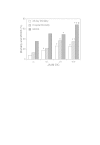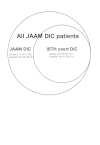A multicenter, prospective validation study of the Japanese Association for Acute Medicine disseminated intravascular coagulation scoring system in patients with severe sepsis
- PMID: 23787004
- PMCID: PMC4056654
- DOI: 10.1186/cc12783
A multicenter, prospective validation study of the Japanese Association for Acute Medicine disseminated intravascular coagulation scoring system in patients with severe sepsis
Abstract
Introduction: To validate the Japanese Association for Acute Medicine (JAAM) disseminated intravascular coagulation (DIC) scoring system in patients with severe sepsis, we conducted a multicenter, prospective study at 15 critical care centers in tertiary care hospitals.
Methods: This study included 624 severe sepsis patients. JAAM DIC was scored on the day of diagnosis of severe sepsis (day 1) and day 4. Scores for disease severity and organ dysfunction were also evaluated.
Results: The prevalence of JAAM DIC was 46.8% (292/624), and 21% of the DIC patients were scored according to the reduction rate of platelets. The JAAM DIC patients were more seriously ill and exhibited more severe systemic inflammation, a higher prevalence of multiple organ dysfunction syndrome (MODS) and worse outcomes than the non-DIC patients. Disease severity, systemic inflammation, MODS and the mortality rate worsened in accordance with an increased JAAM DIC score on day 1. The Kaplan-Meier curves demonstrated lower 1-year survival in the JAAM DIC patients than in those without DIC (log-rank test P<0.001). The JAAM DIC score on day 1 (odds ratio=1.282, P<0.001) and the Delta JAAM DIC score (odds ratio=0.770, P<0.001) were independent predictors of 28-day death. Dynamic changes in the JAAM DIC score from days 1 to 4 also affected prognoses. The JAAM DIC scoring system included all patients who met the International Society on Thrombosis and Haemostasis overt DIC criteria on day 1. The International Society on Thrombosis and Haemostasis scoring system missed a large number of nonsurvivors recognized by the JAAM scoring system.
Conclusions: The JAAM DIC scoring system exhibits good prognostic value in predicting MODS and poor prognosis in patients with severe sepsis and can detect more patients requiring treatment. Conducting repeated daily JAAM scoring increases the ability to predict the patient's prognosis.
Figures


Comment in
-
Another step in improving the diagnosis of disseminated intravascular coagulation in sepsis.Crit Care. 2013 Aug 23;17(4):448. doi: 10.1186/cc12859. Crit Care. 2013. PMID: 24103584 Free PMC article.
-
Is early treatment of disseminated intravascular coagulation beneficial in septic patients?Crit Care. 2014 Jul 4;18(4):447. doi: 10.1186/cc13971. Crit Care. 2014. PMID: 25043475 Free PMC article. No abstract available.
-
Authors' response.Crit Care. 2014;18(4):447. Crit Care. 2014. PMID: 25320744 No abstract available.
References
-
- Gando S, Kameue T, Nanzaki S, Nakanishi Y. Disseminated intravascular coagulation is a frequent complication of systemic inflammatory response syndrome. Thromb Haemost. 1996;17:224–228. - PubMed
-
- Levi M de Jonge E, van der Poll T. Sepsis and disseminated intravascular coagulation. J Thromb Thrombolysis. 2003;17:43–47. - PubMed
-
- Gando S. Microvascular thrombosis and multiple organ dysfunction syndrome. Crit Care Med. 2010;17(Suppl):S35–S42. - PubMed
-
- Wada H, Wakita Y, Nakase T, Shimura M, Hiyoyama K, Nagaya S, Mori Y, Shiku H. Mie DIC Study Group. Outcome of disseminated intravascular coagulation in relation to the score when treatment begun. Thromb Haemost. 1995;17:848–852. - PubMed
Publication types
MeSH terms
LinkOut - more resources
Full Text Sources
Other Literature Sources
Medical
Miscellaneous

